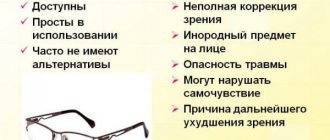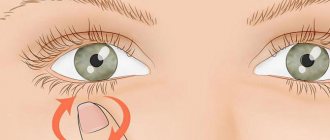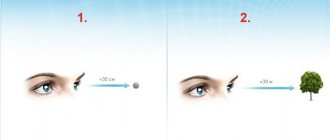What lenses are used in glasses for farsightedness?
Let's start with the main thing - by considering the properties and functions of lenses used to correct hypermetropia. As we have already mentioned, with this visual disorder, the focus of light rays shifts behind the retina, therefore, it needs to be returned to its place, in the area of the macula (macula). To achieve this, it is necessary to increase the refraction, because the patient’s cornea and lens are not coping with their tasks. Therefore, farsightedness glasses must be equipped with convex converging lenses.
Is farsightedness a plus or a minus? Of course, this is a “plus”, because the optical characteristics of the eye need to be enhanced. And myopia is a “minus”, since the focus of light rays shifts forward, and it needs to be moved back to the retina, weakening the refraction with the help of concave diverging lenses.
Refractive indexes (refraction) are measured in diopters. In this case, in the center of the scale there is zero, which corresponds to normal one hundred percent vision, or scientifically “emmetropia”. A deviation in the negative direction corresponds to myopia (myopia), and a positive deviation corresponds to hypermetropia (farsightedness). The more pronounced this deviation is, the thicker the lenses required for optical correction will be. This means that the glasses will be quite bulky, and it will be more difficult to choose a harmonious and reliable frame for them.
Let's take a closer look at this dependence:
- Weak degree of hypermetropia
(from +0.1 D to +3 D) – the accessory will be light and comfortable, with thin lenses that will fit absolutely any frame, the main thing is that the person likes it and suits him. Such glasses are usually prescribed to older people for reading and computer work, that is, for occasional use;
- Average degree of hypermetropia
(from +3 D to +6 D) – devices of this type are designed to be worn constantly, without them it will be difficult for a person to function in everyday life, since near vision is seriously weakened. The lenses in such glasses are already quite thick, so the frames should be wide, strong, made of modern polymers, black or colored. Thin metal arms will look ridiculous and won’t withstand the load;
- High degree of hypermetropia
(more than +6 D) - such lenses require a very careful approach to design, and not only because of their massive appearance, which can only be compensated for by a transparent or very light frame. First of all, it must be stable and reliable so that the glasses do not fall off during wear and serve the owner for as long as possible.
Prevention of mild myopia
The most useful form of prevention for low-grade myopia is physical activity. The ideal option is swimming, in which the heart rate is optimal. This load causes blood flow to the eyes and improves the functioning of the ciliary muscle. In the process of visual gymnastics, the eyes receive the necessary load by focusing on objects located at different distances.
Prevention of low myopia:
- Wearing glasses and contact lenses if necessary - correcting myopia during high visual load is important. To prevent eye strain, you can do this not constantly, but as needed.
- Daily visual gymnastics - for myopia, you need to perform exercises several times a day, choosing the appropriate author’s technique.
- Balanced diet - your daily diet should contain foods high in vitamins A, E, C, B, as well as lutein.
- Using eye drops with vitamins that improve metabolism in the organs of vision.
- Physical activity, hardening - the stronger a person’s immunity, the less likely it is that his body will be attacked by viruses and colds, which means that conditions will not be created for the progression of myopia.
- Breaks during visual stress, adherence to sleep, rest and work - during sleep, the organs of vision become less active, they rest and recover, so you should not deprive your body of such a useful preventive break.
Eye exercises are aimed at training accommodation; they also improve metabolism and blood circulation, and contribute to the overall health of the visual organs. If you do exercises regularly, they can really help improve your vision and bring it back to normal.
Features of choosing glasses for farsightedness
Successful selection of an optical accessory depends on several aspects, including:
- Results of examination by an ophthalmologist
. To determine the degree of hyperopia, methods such as skiascopy, refractometry, accomodometry and some others are used - the need to use additional methods is determined by the doctor depending on the individual characteristics of the patient. Most of these tests are carried out under conditions of artificially created rest of accommodation, which is achieved by instilling atropine sulfate into the eyes. Moreover, the indicators in diopters are established for each eye separately, since in almost all people refractive errors manifest themselves differently in different eyes. It is also necessary to measure the distance between the pupils and confirm the absence of binocular visual defects;
- Distance from the eyes to the lenses and to the objects in question
. Properly selected glasses for farsightedness ensure clear visualization of objects located 32-35 centimeters from the face. In this case, the glasses should sit so that there is a gap of 12 millimeters between the cornea and the glasses;
- Need for constant or occasional wearing of glasses
. The choice of the type of optical accessories directly depends on this point, among which there are glasses “for near” and “for distance,” as well as devices with multifocal lenses that allow continuous use and clear vision at any distance. Such glasses are simply irreplaceable for people who are nearsighted and farsighted at the same time. As for age-related presbyopic disorders, a person usually has enough single-vision accessories for reading and painstaking work, which he will use as needed;
- Patient's age and occupation
. Obviously, the main criteria for choosing glasses for farsightedness in a child or an elderly person are convenience, reliability and safety, while image is very important for young people. But that’s not all - there are professions that require clarity of vision at a certain distance other than the typical 32-35 cm. For example, a musician needs to see notes when the music stand is 60 cm from his face, and a cook would like to cut food without bending over the cutting board. The doctor must take all these points into account when selecting glasses for farsightedness.
When you have the prescription in hand, all you have to do is visit an optical salon and purchase the appropriate accessory. But don’t rush to go home - walk around a little in your new clothes, listen to your feelings. If within 15-30 minutes there is no discomfort (burning, stinging, tearing, blurriness, double vision), then the glasses are suitable for you.
For obvious reasons, we will not consider here such aspects as the brand of lenses or the type of frame - this is the lot of commercial organizations that sell optics. Let’s just say that a good quality accessory is not necessarily expensive, and that if you have nearsightedness and farsightedness at the same time, it is more profitable to purchase one multifocal glasses than several separate ones “for near”, “for distance” and for working at the computer.
Frame and glass for glasses
Eyeglass frames are not just a fashion accessory. The theory that absolutely any glass can be inserted into any frame may not always be appropriate. Some recommendations that it is advisable to follow when selecting lenses are listed below.
Myopia and its degree of progression greatly influence the type of frame when choosing glasses. When choosing a frame, you should also be guided by the comfort of looking through the glass in it. Since the limitation of vision in a dark frame can be uncomfortable for an unaccustomed person.
A person with early myopia can choose any frame:
plastic; iron; rimless glasses.
The most comfortable wear is found when using a metal frame. In addition, this is a classic variety that is durable and appropriate for any event. Spraying can be of different shades. It will add elegance and beauty to the wearer.
For moderate myopia, it is appropriate to choose glasses without frames.
Severe myopia requires wearing thick glasses, so plastic frames will help hide their real thickness. The only significant drawback of such frames is that they are subject to deformation. And unlike a metal frame, frequent replacement of glass will shorten the period of their use.
After deciding on the frame, you should pay attention to the lenses. In the modern world, people who suffer from myopia can choose glasses made from both glass and high-quality plastic.
Traditional glass. The only material from which all types of glasses were previously made. Its quality cannot be disputed. The downside is that the thicker the lens, the heavier it is and if hit, they can easily break. This is especially important to consider for people whose myopia is in an advanced stage.
Glass, unlike plastic, cannot be tinted. Only chameleon glasses can add variety to the color palette.
The plastic solution to the problem is relevant today. Their lightness and durability when dropped is a positive side. Lenses are made from types of plastic such as high-index, polycarbonate and photochromic. The option of tinting and a variety of colors of plastic products is very popular. Athletes with nearsightedness are best suited for polycarbonate lenses, which are even somewhat scratch-resistant. The negative side of plastic lenses is that they do not last long, since small scratches on them distort vision, which is unacceptable for a disease such as myopia.
Everything that a person can see with his own eyes is the truth. Whether he wants to see the world in its true outlines, or whether he wants to continue his journey, stumbling, it’s all up to him to decide.
I read in the next topic about treating myopia with plus glasses. I tried my version of this method for three weeks without two days - I want to write my first impressions. I do it simply - for several hours during the day I wear +1 glasses on top of my regular contact lenses (I wear undercorrected ones). In the morning I get up, put on contacts and glasses, and get ready for work. Then I go to work without glasses. Then I work with glasses for the first half of the day (at this time I don’t need to see very clearly), then for two hours without glasses, and then at the computer - again with glasses. I go home without glasses, and at home I take off my contact lenses and walk either with or without glasses. At first I wore glasses when I walked down the street, but now I’m kind of lazy.
Impression. The result is almost immediate, literally in the first two days: it seems that some kind of spasm is being relieved. The improvement is not the same as with flashes; I still somehow don’t really understand whether the clarity has improved or not. Everything just becomes very bright, voluminous and real! There is a feeling that there is less fog between objects - on the sixth day of classes I just shook an ordinary bush! - I suddenly saw that each leaf in it was on its own, and there was space between them! The fields of vision have expanded, usually I see as if in a narrow beam, but here there is such space! The feeling that you are looking from the bottom of your eyes, and most importantly, it is the feeling of the extraordinary reality of what is visible. The impression that you can touch objects with your gaze. As if the eyes had come out of some kind of paralysis. But in terms of clarity, I don’t understand. The general impression is that my vision has become much better, but I have my own test - at work, from the height of my considerable height, I have to see small and pale numbers in the printout lying on the table. So I don't notice any special changes. More precisely, in winter I wore lenses -4.75, and now -4.0. But in the summer I always lower the diopters in my glasses/lenses - the lighting is different and I see better in the summer.
Also on topic - I’m a little over forty, but I haven’t noticed any signs of age-related farsightedness yet (I knit lace from bobbin silk - no problem.
Maybe someone will also try this method - then write your impressions, please!!
If you are over 40 years old, you have never worn glasses, and one day you are surprised to discover that you cannot see the newspaper even at arm's length, do not panic - it is time to contact an ophthalmologist to choose reading glasses.
What is presbyopia?
The accommodative function of the lens—the ability to change its shape—is responsible for vision at various distances. At a young age, the lens is elastic; when looking at nearby objects, under the action of the muscles attached to it, the lens becomes more convex and refracts light more strongly, thereby focusing the image on the retina.
With age, the lens becomes denser, less elastic and loses its ability to accommodate. The closest point of clear vision gradually moves away from the eyes, visual strain appears, it is difficult to thread a needle, and when reading you move the book or newspaper further and further away from you. This phenomenon is called presbyopia or age-related farsightedness.
Presbyopia gradually progresses according to age norms.
Presbyopia gradually progresses, requiring replacement of near glasses with stronger ones approximately every 5 years. There are age-specific norms for presbyopia. At the age of 40, for reading, plus glasses with a power of 1.0 D are required, at 45 years old - 1.5 D, at 50 years old - 2.0 D, at 55 years old - 2.5 D, at 60 years old - 3.0 D, at 65 years old - 3.5 D. Further, age-related farsightedness does not progress, since the lens completely loses its elasticity.
For those who are farsighted, the age norm for presbyopia is added to distance glasses. In case of myopia, distance correction is subtracted from this age norm. Myopic people can read for a long time without glasses.
If you do not wear distance glasses, you can use regular monofocal reading glasses. At the same time, if you look into the distance in them, the image will be blurry. Therefore, half-length glasses with narrow lenses are very popular; when looking into the distance, you look over the glasses lenses.
Ready-made glasses always have the same lens power for both eyes and an average interpupillary distance.
You can order glasses or buy ready-made ones.
In the first case, you choose any suitable frame and choose lenses that have certain properties you need. The cost of glasses will vary depending on the price of the frame, lenses and the work of the specialist. Depending on the salon, making glasses to order will take from a couple of hours to several days.
There is a large selection of ready-made glasses on sale. They are much cheaper than those made individually according to your order. Small in size or even foldable, they fit easily in your pocket. Often sold together with an eyeglass case.
By choosing ready-made glasses, you save time spent waiting for glasses to be made to order. But ready-made glasses always have the same lens power for both eyes and an average interpupillary distance, usually 62-64 mm. If your interpupillary distance is significantly different, then reading with such glasses can cause headaches, lacrimation, and pain in the eyes.
If you need glasses with different lens strengths for the right and left eyes, then ready-made glasses will not suit you either. In addition, as a rule, the lenses in ready-made glasses do not have any additional coatings, such as hardening, antireflection, etc., so they are easily scratched and cannot provide high quality vision.
If you use distance glasses, then bifocal, trifocal or progressive glasses are suitable for you to see well both in the distance and near. Such glasses are always made only to individual order due to their complexity.
Should I wear glasses all the time if I am farsighted?
It’s definitely not a good idea to start wearing glasses without taking them off immediately after you first purchased them. You need to give your eyes time to get used to the accessory, usually two weeks is enough for this. If after this period you still feel uncomfortable wearing glasses, especially if wearing them is accompanied by unpleasant symptoms, it is better to visit an ophthalmologist and tell about the problem. You may need to change the lens specifications or choose a different frame.
As for the very need to constantly wear glasses for farsightedness, this depends on the severity of the pathology and its combination with other disorders. If a person simply has an age-related decrease in near visual acuity within 3 diopters, and at a far distance the visualization remains clear, he does not need to always wear glasses - it is enough to put them on as needed. If a patient has moderate to high hyperopia, especially in an adult or elderly person, this almost always means that he has poor vision both near and far, and therefore needs to constantly wear glasses.
If you see well close up, but after 30-60 minutes of active use of your vision you feel the effect of “sand poured into your eyes”, headache, photophobia, pressure in the forehead, eyebrows and eye sockets (asthenopic syndrome), then your accommodation resource is at the limit, and you should choose glasses for farsightedness.
Optical correction is not a method of treating hypermetropia, but if measures are taken on time, further wear and tear of the visual system is inhibited. That's why you shouldn't neglect your doctor's advice if he recommends you start wearing glasses. In addition, if you have already been diagnosed with visual impairment, you should regularly see an ophthalmologist to monitor the dynamics of changes and select appropriate optical accessories. A sharp deterioration in health, the appearance of severe headaches, diplopia (double vision), a feeling of fullness in the eyeballs should be a reason to immediately go to the hospital in order to avoid serious complications (glaucoma, cataracts, blindness).
Video: How to choose glasses? Shapes, frames, materials:
Use of glasses with varying degrees of myopia
Myopia is a disease that needs to be monitored. Taking good care of your vision helps prevent the progression of the disease, which is already beginning to undermine the body. The use of corrective products is one of the options to free yourself from tension in the eye area. Glasses for myopia are used depending on the severity of myopia.
There are three degrees of myopia:
first stage (or initial); average degree of myopia; high degree.
The first stage (or initial) is determined by visual acuity of up to three diopters. A person with such myopia can easily do without corrective means. Prescribing glasses is advisable if you want to prevent your vision from continuing to deteriorate. The quality of vision in them reaches 100%, and they are used only for distance viewing.
Moderate myopia is accompanied by a drop in vision from three to six diopters. With this degree of myopia, glasses become an integral part of a person’s accessory. The distance between the maximum possible visibility decreases, and then bifocal glasses can be prescribed, which have a complex glass structure consisting of two-level vision correction. The upper part of the glass improves the view into the distance, and the lower part improves the view at a close distance. With this degree of myopia, glasses may not be prescribed with 100% sharpness, since it is difficult for eyes already accustomed to blurred outlines to get used to clear outlines. People with moderate severity of the disease usually come to the conclusion that they cannot do without glasses. And they are just beginning to apply such an adjustment, adaptation to which is difficult.
A high degree of myopia is defined if vision decreases by more than six diopters. In this case, the patient is prescribed glasses with an acceptable minus, since a 100% correction will be accompanied by discomfort.
Return to contents
Does a child with farsightedness need glasses?
Early childhood is characterized by physiological hypermetropia, since the baby’s eyeballs have grown and are not fully formed - they are shorter in the direction of the anteroposterior axis compared to the same indicator in an adult.
Therefore, the focus of the light rays is located somewhat further than necessary, but this phenomenon, firstly, is compensated by accommodation (a change in the curvature of the lens), and secondly, it is reversible: as soon as the eyes grow, the correct relationships between their internal structures will be established.
For a one-year-old baby, farsightedness is considered normal in the range from +2.5 to +3 diopters, for a two-year-old child - from +2 to +2.5, for a three-year-old - from 1.5 to 2. By the age of four, most children already have one hundred percent vision.
A peculiar milestone is the age of seven, when a child first goes to school. If at the same time he has an uncorrectable refractive error, the educational process will be significantly complicated, because such a first-grader has poor close-up vision. Even if hypermetropia is compensated by efforts of accommodation, but this happens at the limit of possibilities, problems cannot be avoided: headaches, lacrimation and photophobia will appear, the child will begin to rub his tired eyes with dirty hands, simultaneously introducing an infection there and provoking the development of complications - conjunctivitis, blepharitis, keratitis.
Therefore, if your son or daughter complains of rapid visual fatigue, or you yourself notice corresponding alarming symptoms while your child is still very small and cannot talk about his problem, be sure to contact a pediatric ophthalmologist. This is especially true for children under three years of age with moderate and high degrees of hyperopia - if they are not prescribed glasses for farsightedness in time, they may develop strabismus, and then amblyopia (lazy eye syndrome). In addition, disruption of the outflow of intraocular fluid threatens glaucoma. Dealing with such complications is very difficult.
Thus, if the doctor discovered that your child is farsighted and recommended wearing glasses, you need to listen to his advice and come to the appointment regularly to monitor the changes that are occurring and make timely adjustments to treatment tactics. Surely, parents of children with hypermetropia will be pleased to know that most of these children cease to need optical vision correction in the lower grades of school, and sometimes even before entering school. This is due to the incredible ability of the child’s body to grow and adapt to the conditions of the surrounding world.
How to choose the right glasses for a child with farsightedness?
Here are some important points to consider when choosing children's optics:
- Lenses
plastic ones are preferable, although they wear out relatively quickly, become covered with small scratches and become cloudy. But when it comes to accessories for a child, this is not so important, since you will probably have to change them often. It is much more important that the glasses do not break and injure the baby, so it is better to avoid glass lenses;
- Frame
It should also be plastic, strong enough and durable, and at the same time beautiful from the point of view of the child himself. As a rule, parents have much more difficulty motivating their son or daughter to wear glasses than choosing the right lenses. Therefore, be sure to take into account the opinion of the little patient when it comes to the appearance of accessories;
- Design
Children's optics should be as stable as possible. It is unacceptable for glasses to fall off the face, slant to the sides, or dangle on the ears. At the same time, the temples should not dig into the temples and rub the skin, and the bridge should not leave a depressed mark on the nose. That is why it is so important to take careful measurements, carefully examine the frames, invite the child to walk around with glasses for a while, and only after making sure that he is comfortable, make a purchase. If you are worried that your child might drop his glasses during active games, it is permissible to tie a loose elastic band to the temples and secure the accessory around his head, but it is not advisable to do this all the time - properly selected glasses should sit securely on their own.
Video: ideal glasses for a child:
Age-related farsightedness: which glasses are better?
In the case of presbyopia, a person usually needs glasses that will allow him to read, write and interact with close objects comfortably, since long-distance vision remains satisfactory. But this doesn't always happen. The fact is that age-related farsightedness inevitably develops after 40-45 years in all people, including absolutely healthy people, as accommodation resources are depleted.
The nucleus of the lens undergoes gradual sclerosis, which prevents changes in curvature and the return of the focus of light rays to the surface of the retina. In addition, the ligament of Zinn and the ciliary band, the control elements of the lens, wear out. All this leads to the fact that after 40 years, even people with one hundred percent vision begin to see worse up close. Usually the deviation is within +3 diopters, and after 60 years of age, a further decrease in near visual acuity no longer occurs, because the lens is sclerotic and the accommodation mechanism is completely lost.
With age-related farsightedness against the background of previous emmetropia (100% vision), a person needs monofocal glasses “for near”, which he does not need to wear all the time; it is enough to simply use them as needed.
It is a completely different matter if the patient has had myopia throughout his life. Myopic people experience presbyopia a little later, at 45-50 years of age. This situation results in the fact that, due to the underlying disease, the person sees very poorly at a distance, and due to the aging of the eyes, he now also sees poorly at close range. In such patients, only vision at an intermediate, “average” distance remains relatively clear.
With age-related farsightedness against the background of myopia, a person needs either two glasses - separately “for near” and “for distance” - or one bifocal glasses, which will perform both necessary functions.
The situation is worst with hypermetropes - their presbyopia manifests itself after 35 years. And the older a person gets, the more intensely the distance between the points of extreme clarity of near and far vision decreases. Thus, by about 50 years of age, the patient cannot see all objects well and needs to constantly wear glasses.
In case of age-related farsightedness against the background of hypermetropia, glasses with trifocal or progressive lenses are best suited for a person.
Video: vision correction for presbyopia (farsightedness):
Bifocal and trifocal glasses
In the first case, the lens has two areas: the upper, larger and wider, provides clear vision at a distance, and the lower, smaller and narrower, is needed for good visualization near. That's why glasses are called bifocal. They have obvious disadvantages - firstly, there is no area that would be suitable for considering medium-distance objects. Secondly, the difference in optical power between the upper and lower parts of the lens cannot exceed three diopters (usually even two), since then the eyes will not be able to adapt to the sharp difference. Thirdly, the border between individual areas of the lenses is clearly visible, and this betrays age, hints at significant vision problems, and visually enlarges the lower eyelids, creating the effect of “bags under the eyes.”
In the second case, in the middle between the upper and lower optical zones there is another one, designed specifically for clear vision at an average distance. This allows you to neutralize the first drawback, but does not cancel the others. Many older people refuse to wear trifocal glasses for farsightedness, since using them is even more difficult than bifocals - the eyes take a long time to get used to, the picture “floats” when the gaze is sharply shifted from a near to a distant object.
Progressive glasses
The most modern way to correct myopia and farsightedness at the same time is glasses with progressive lenses. They provide a gradual increase in optical power from top to bottom. There are no sharp transitions between individual zones, the accessory looks more aesthetically pleasing. If you learn to use such glasses correctly, you can wear them all the time and clearly see objects located at any distance.
To do this, you need to slowly move your eyes in a vertical direction, choosing an object and trying to see it as clearly as possible. For example, you can sit on the sofa, direct your gaze to the top of the lenses and focus on the wall clock hanging on the opposite wall. Then look into the middle part of the lens and through it examine the vase standing on the table in the center of the room. Then look at the bottom of the lenses and read the text from the book you are holding in your hands. By repeating such manipulations, you will gradually train your eyes to quickly focus vision on objects at different distances using the most suitable areas of the lenses.
Progressive glasses for farsightedness also have disadvantages: firstly, they significantly narrow the field of view. To view an object located from the side, you will have to turn your head so that it falls into the center of the lenses - simply squinting your gaze will not work. Secondly, not all people can get used to such devices, especially if we are talking about an elderly person who has previously used monofocal or bifocal glasses for a long time. Thirdly, products with progressive lenses are the most expensive of all types of optics.
For older people, the main thing is convenience, and this criterion should be followed when choosing optical accessories. If it is easier for a person to have two pairs of glasses, separately for near and far vision, so be it, than if he has only one, technically advanced glasses, which he cannot use normally.
Disadvantages of progressive lenses
Progressive lenses are not ideal; they have disadvantages that may not be suitable for certain categories of patients:
- blind spots on the sides of the glasses, where it is impossible to focus;
- the transition from plus to minus is very narrow;
- a long adaptation period, during which a person gets used to wearing optics with progressive lenses, some categories of patients will not be able to use these glasses;
- higher cost compared to regular bifocals.
If a person cannot get used to progressive glasses for a long time, there is no need to stop wearing them. Over time, the adaptation period will pass, and the person will gain clarity of vision. Manufacturers are constantly trying to improve these optics, so you should periodically consult with an ophthalmologist.
Makeup for glasses for farsightedness
Since lenses with certain optical properties are installed in glasses, a woman’s face in such an accessory can be completely transformed, and these changes will not always suit the owner. For example, “minus” lenses make the eyes visually smaller and narrower, while “plus” lenses, on the contrary, make them larger and rounder. This significantly changes the proportions of the face. Let's figure out how to give harmony to your new look.
Let's start with general recommendations for the use of decorative cosmetics for those women who constantly wear glasses:
- If you have glasses with black or any other contrasting frames, avoid bright and dark eye makeup, especially in the smoky eyes style - this will create an aesthetic conflict and look vulgar;
- For girls with glasses, it is better to put a color accent on the lips to balance the lower and upper parts of the face, especially in the case of complex, visible frames. Otherwise, your face will be “lost”; people will first of all notice your glasses;
- Apply mascara from the very root of the eyelashes using zigzag movements. If you paint the ends too much, the eyelashes will droop over time, begin to rest against the glasses, and the mascara will fall off;
- Carefully conceal under-eye circles and bags with concealer (if any), as glasses greatly highlight these imperfections, especially if you have plus or bifocal lenses. For the same reason, if you are farsighted, you should not paint your lower eyelashes or apply dark shadows to your lower eyelids - you will look tired;
- Do not draw wide arrows if you have compact glasses with thin frames - this will add dissonance to your image. With massive glasses with thick frames, it is better not to apply eyeliner at all, but to use only shadows;
- Eyebrows are meant to blend in with your frames, so they shouldn't be too wide or too bold if you have delicate glasses. The shape of the eyebrows also needs to be correlated with the shape of the frame - for example, angular eyebrows will look strange in combination with rounded lenses, and vice versa;
- Use a light foundation and set your makeup with translucent powder. Remember that foundation applied too thickly will almost certainly be imprinted on your glasses and “float” in the places where they come into contact with your face.
If you are farsighted, glasses will visually enlarge your eyes and distort their proportions, making them unnaturally round and close-set. Therefore, do not overuse too much bright makeup and paint your eyes so as to visually stretch them towards the temples and move them away from each other.
The optimal makeup option for glasses for farsightedness is to apply light shadows to the inner corners of the eyes, and darker and more contrasting ones to the outer corners. Arrows also help to cope with the task, but they need to be correctly combined with the frame. It is best to simply outline the eyes along the entire contour, this will help make them visually smaller.
Video: makeup with glasses - life hacks:
Rules for storing and caring for glasses
Choosing glasses for farsightedness is not everything; you need to learn how to use and store them correctly so that the accessory will last you as long as possible, especially if we are talking about expensive optics.
How to wear?
Glasses should not be worn on the head like a hairband - this leads to stretching of the temples and loosening of the screws at the attachment point. For the same reason, you should not remove the product from your face with one hand, making a “tearing” movement to the side. Very soon the regularly damaged bow will fall off. You must remove glasses with both hands, carefully and confidently grasping them by both temples - this is the only way to prevent them from falling. There is no need to wear glasses like a necklace, hanging them on a chain on your chest for fear of losing them. You may accidentally hit something with them and break them. If you need to adjust your glasses on your nose, do not do so by pressing the pad of your finger against the bridge, especially if the product has a colored frame. Otherwise, a stain will form in the most visible place, and the accessory will look ugly. You need to adjust your glasses by holding them by the lens with two fingers, top and bottom. This will also prevent the bridge from becoming loose due to constant pressure on it.
How to store?
The optical product should not come into contact with hard objects that could damage its design and scratch the lenses. Glasses should be placed on the table with the glasses facing up and stored in the case in the same position. It should be dense, like a snap-on box, well-suited in size (the product should not dangle in it). Soft cases are a bad idea; the lenses will constantly fidget on their inner surface and collect microdamages. In any case, you should not leave them for a long time, much less store your glasses in the bathroom or kitchen, where there is high humidity and there is a risk of aggressive liquids getting in. High temperatures are especially harmful for plastic lenses - the optical functions of the product can be impaired. Any lenses “do not like” the effects of perfumes and deodorants, so you should preen yourself without glasses.
How to clean?
It is recommended to wipe the optics daily using a special soft microfiber cloth, which is best stored in the case along with the glasses. Coarser cloth or paper napkins are not suitable for this purpose - they will leave microscopic scratches on the lenses. Presbyopia glasses can be washed like any other similar devices, but only using non-aggressive household chemicals, such as liquid soap.
Features of glass lens care
Glass lenses are more durable and scratch-resistant, but at the same time they are heavy and fragile - they can simply break if dropped. High hypermetropia requires very massive lenses, therefore, if they are glass, the total weight of the product will be impressive, and such glasses will have to be worn carefully. Caring for optics with glass lenses is very simple - you need to wash it and wipe it with microfiber, but remember that if a special polymer coating is applied to the glass, for example, to protect it from ultraviolet radiation, such an accessory cannot be treated with fat-dissolving compounds, such as vinegar or dishwashing detergent, windows and mirrors.
Features of caring for plastic lenses
Plastic lenses have many advantages: they are inexpensive, lightweight, durable and comfortable. But at the same time they wear out very quickly, becoming covered with small scratches and stains. The main thing in caring for glasses with plastic lenses is caution and delicacy. They can only be wiped with microfiber, stored in a hard case, washed with shampoo or liquid soap, and only with cool water, never hot!
In conclusion, I would like to say that high-quality and correctly selected glasses for farsightedness will last you at least three years if you take good care of them. You may need to replace your lenses sooner due to damage or simply because your vision has changed and the optics are no longer suitable for you. In any case, the frame must withstand at least three years of use. Take care of your eyes and be healthy!
Author of the article: Marina Vitalievna Degtyareva, ophthalmologist, ophthalmologist











